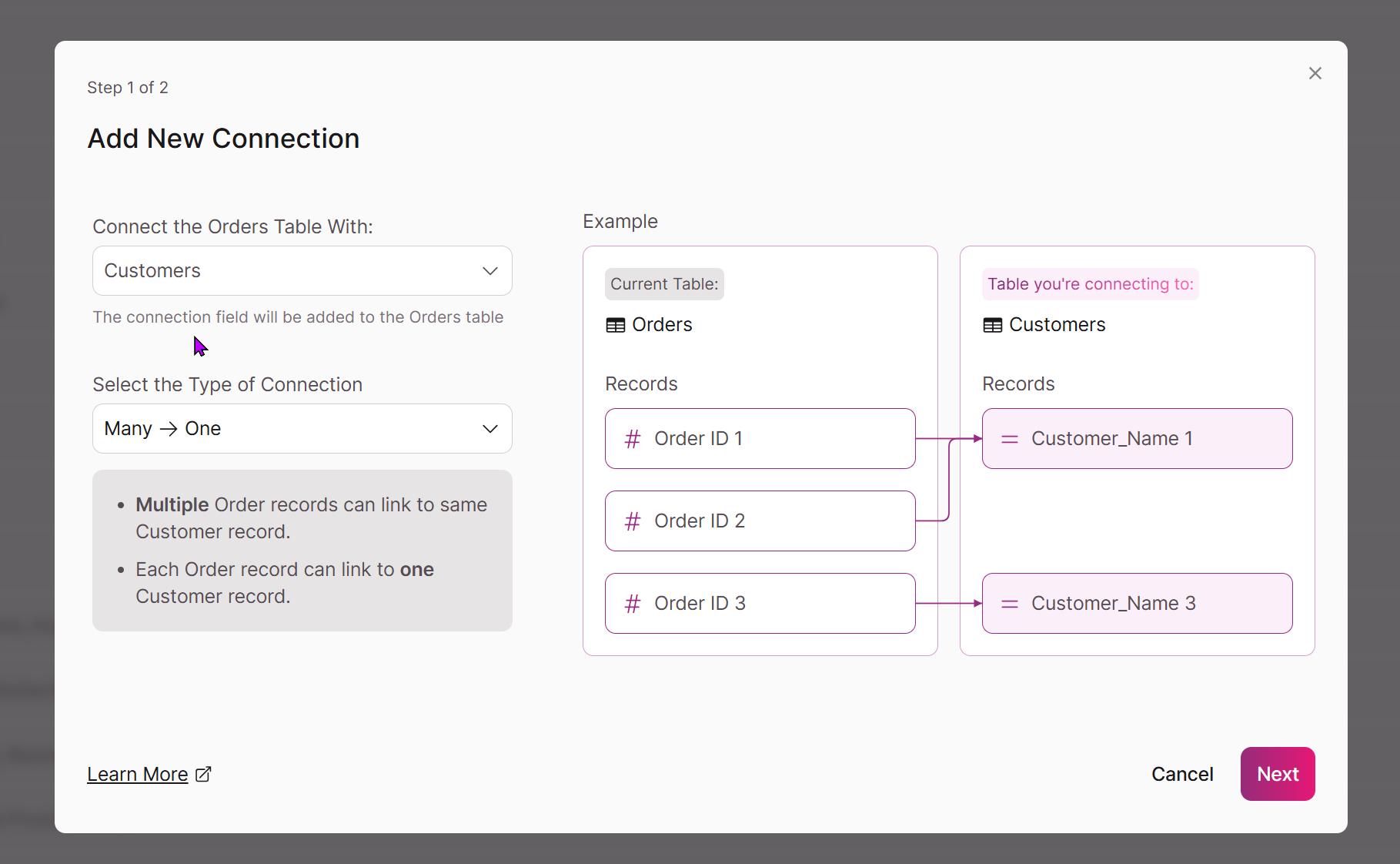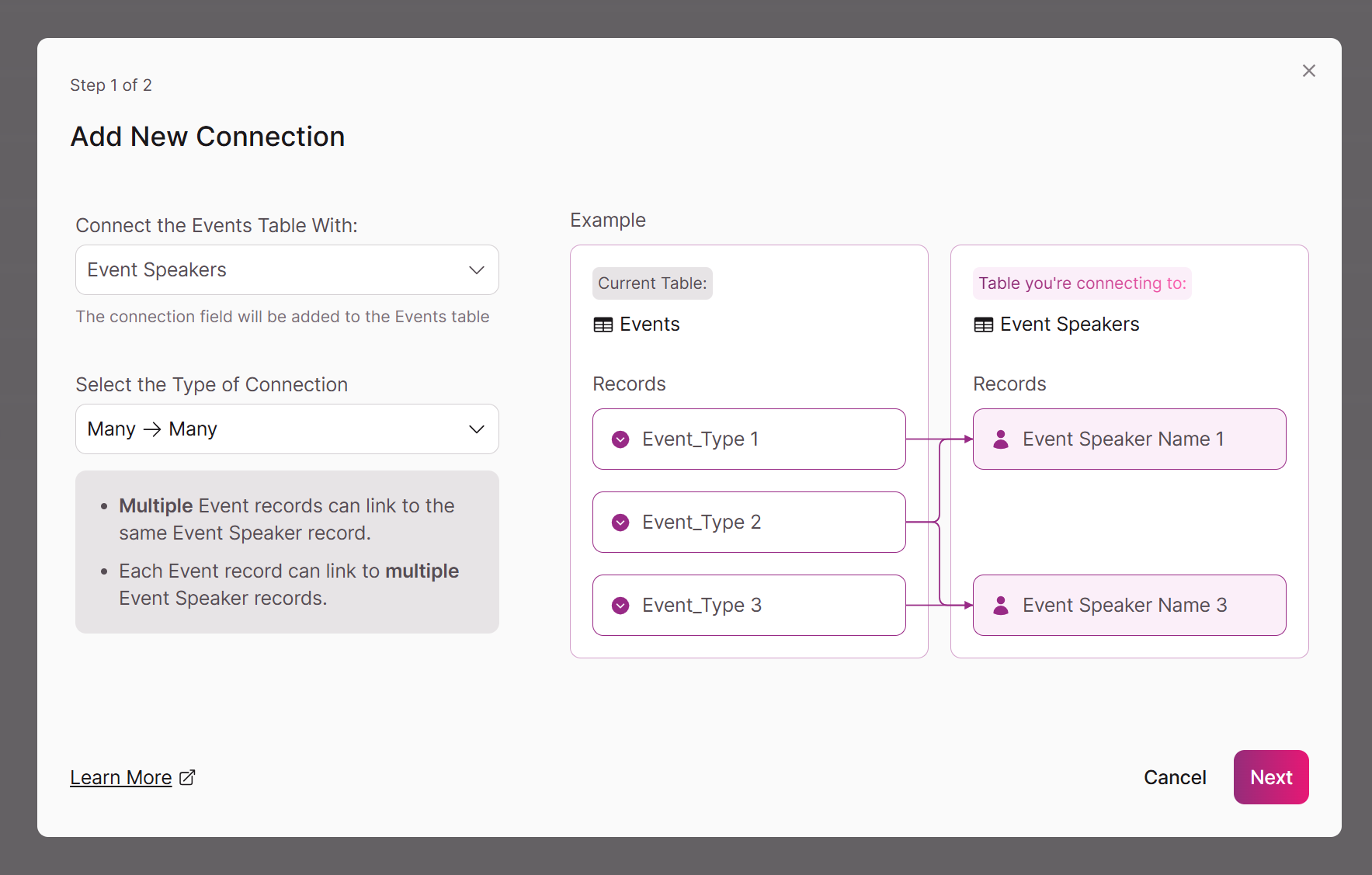Mastering Connections in Knack: A Complete Guide
This comprehensive guide will help you understand, plan, and implement table relationships that grow with your needs while avoiding common pitfalls that can complicate your application later.
Think of your Knack app like organizing a really smart filing cabinet. Instead of having papers scattered everywhere, you want everything connected and easy to find. That's exactly what table relationships do - they help your data work together like a well-organized team.
Why This Matters
Let's start with a simple truth: disconnected data is frustrating data. Without relationships, you end up doing the same work over and over again. Imagine having to type a customer's address every single time you create an order for them.
When your tables are properly connected, intuitive and efficient flows happen:
- No more repetitive typing – Information flows automatically where it needs to go
- Everything stays in sync – Update a customer's phone number once, and it updates everywhere
- Better insights – You can finally see the big picture with reports that actually make sense
- Happier users – Your team spends time on important work, not data entry
The Three Types of Relationships
Knack has three types of connection relationships, and they're pretty intuitive once you see them in action.
Many-to-One: The "Belongs To" Relationship
What it is: Lots of things belong to one thing.
Think of it like:
- Many employees work for one company
- Many books are written by one author
- Many tasks belong to one project
When to use it: Whenever you're organizing or categorizing things. This is probably 80% of the relationships you'll create.
Real example: You have a table of Orders and a table of Customers. Each order belongs to one customer, but customers can have many orders. Create the connection field while you're on the Orders table.

Many-to-Many: The "Collaboration" Relationship
What it is: Things on both sides can connect to multiple things on the other side.
Think of it like:
- Students take multiple classes, and classes have multiple students
- Authors write multiple books, and books can have multiple authors
- Employees work on multiple projects, and projects have multiple team members
When to use it: When you need maximum flexibility and things naturally work together in multiple combinations.
Real example: You're planning events. Each event has multiple speakers, and speakers can present at multiple events. Either table can have the connection field - pick whichever makes more sense for how you work.

One-to-One: The "Detailed Information" Relationship
What it is: Each thing has exactly one matching thing.
Think of it like:
- Each employee has one personnel file
- Each product has one detailed specification sheet
- Each customer has one billing profile
When to use it: When you want to separate information for organization or security reasons, but each record only connects to one other record.
Real example: You have basic customer information in one table and detailed billing information in another (maybe for security). Each customer has exactly one billing profile.

How to Choose the Right Type
Here's a simple way to figure out which relationship type you need:
Ask yourself these questions:
-
Can one thing connect to many things on the other side? If yes, it's not One-to-One.
-
Can things on both sides have multiple connections? If yes, it's Many-to-Many.
-
Does this feel like organizing or categorizing? If yes, it's probably Many-to-One.
-
Are these things working together as equals? If yes, it's probably Many-to-Many.
Still not sure? Start with Many-to-One. It's the most common.
Planning Your App
Before you start clicking around and creating relationships, take 15 minutes to sketch out your plan.
Step 1: List Your "Things"
Write down all the important things your business tracks:
- People (customers, employees, vendors)
- Items (products, orders, projects)
- Events (meetings, deliveries, appointments)
- Categories (departments, product types, locations)
Step 2: Draw the Connections
On paper (yes, actual paper!), draw lines between things that need to connect. Don't worry about getting it perfect—just get the basic relationships down.
Step 3: Ask "What Connects to What?"
For each line you drew, ask:
- Does this thing belong to that thing? (Many-to-One)
- Do these things work together? (Many-to-Many)
- Is this just detailed information? (One-to-One)
Step 4: Start Simple
Pick the most important 2-3 relationships to build first. You can always add more later.
Setting Up Your First Connection
Ready to actually build something? Here's how to create a connection that works properly:
Step 1: Pick the Correct Table
- For Many-to-One: Put the connection field on the "many" side (Orders connect to Customers, not the other way around)
- For Many-to-Many: Pick the table where you'll most often select a connected value
- For One-to-One: Either table works—pick the one you use most
Step 2: Choose a Great Display Field
This is what users see when picking connections. Make it helpful:
- Good: "Acme Corporation - John Smith"
- Not so good: "Customer #12847"
- Better: Combine multiple fields if needed with a text formula
Step 3: Test It Out
Create a few test records and try making connections. Does it feel natural? Can you find what you're looking for easily? If not, try changing or adjusting the display field.

Connections really show their power in the live app, not just in the builder. Create a form that includes your connection field and test it like a real user would. You'll quickly see if your setup makes sense or if it needs tweaking. Try creating a few records through the form - this is where you'll discover if your display fields are helpful and if the connection process feels smooth.
Common Advice
Mistake #1: Creating too many connections at once
Solution: Start with 2-3 key relationships. Add more after you're comfortable.
Mistake #2: Using confusing display fields
Solution: If users can't easily identify what they're connecting to, fix the display field first.
Mistake #3: Not thinking about the user experience
Solution: Put connection fields where users expect them. If it feels awkward, it probably is.
Mistake #4: Overcomplicating simple scenarios
Solution: Most relationships are Many-to-One.
Mistake #5: Not testing with real data
Solution: Test with realistic data and real workflows before going live.
Real Examples That Make Sense
Let's look at some common business scenarios and how to handle them:
Small Business Customer Management
What you need: Track customers and their orders
Tables: Customers, Orders
Relationship: Customers (one) to Orders (many) - Many-to-One
Setup: Put a connection field while on the Orders table that connects to Customers. The display field could be "Company Name - Contact Name"
Event Planning
What you need: Manage events with multiple speakers and attendees
Tables: Events, Speakers, Attendees
Relationships:
- Events to Speakers: Many-to-Many (events have multiple speakers, speakers can do multiple events)
- Events to Attendees: Many-to-Many (events have multiple attendees, people can attend multiple events)
Setup: Put connection fields on whichever table you use most for adding these relationships.
Project Management
What you need: Track projects, tasks, and team members
Tables: Projects, Tasks, Team Members
Relationships:
- Projects (one) to Tasks (many) - Many-to-One
- Projects to Team Members - Many-to-Many
- Tasks to Team Members - Many-to-One (if each task has one person) or Many-to-Many (if tasks can have multiple people)
Setup: Start with Projects to Tasks (Many-to-One), then add team member connections based on how you actually assign work.
Troubleshooting Common Issues
Problem: "I can't find the record I want to connect to"
Solution: Check your display field. Make it more descriptive or add search functionality.
Problem: "The connection dropdown is really slow"
Solution: More than 10,000 values in a dropdown can cause this. Consider filtering options or breaking large tables into smaller ones.
Problem: "Users keep making the wrong connections"
Solution: Improve your display field to make options more distinct, or add rules to show only relevant choices.
Growing Your App Over Time
Check-ins
- Are users struggling to select the correct data?
- Are there new tables you need to add connections to?
- Is everything still performing well?
Listen to Your Users
Pay attention to:
- Requests for new ways to select data
- Confusion about which records to select
Keep It Simple
Each connection should solve a real problem or make something easier.
Your Next Steps
Ready to get started? Here's what to do:
- Pick one simple relationship for your use case (probably a Many-to-One)
- Create it and test it with a few records in the Live App
- Repeat and gradually build your connected tables
Quick Reference
Choosing relationship types:
- Organizing/categorizing things: Many-to-One
- Things working together: Many-to-Many
- Detailed information separation: One-to-One
Where to put connection fields:
- Many-to-One: On the "many" side
- Many-to-Many: On whichever table you use most
- One-to-One: Either table (pick the one you use most)
Making great display fields:
- Use descriptive, unique information
- Combine fields if necessary (Company + Contact Name)
- Test with real users to make sure it makes sense
Getting help:
- Test everything with real data
- Listen to user feedback
- Contact Support if you are stuck!
Building great relationships in Knack is like organizing your workspace and it makes using your app easier in the long run. Setting up connections correctly makes your app powerful and user-friendly.
Updated 8 days ago
